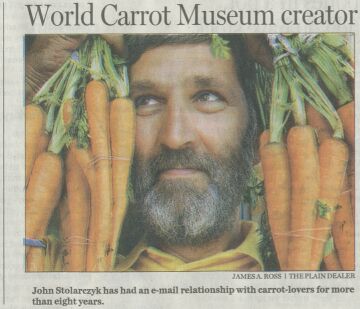
Debbie Snook Cleveland Plain Dealer November 26, 2003 The vegetable-staking vendors and bag-toting shoppers don't realize that the King of Carrots has arrived. On a busy day at Cleveland's West Side Market, John Stolarczyk of Bradford, England, has come to see what we have. He is not alone. Ahead of him is Clevelander Jeff Chiplis, moving in a jazzy, finger-snapping, "My Way" rhythm from one stand to the next. Chiplis stops and holds up loose, topless varieties, small carrots in bags and, finally, bunches with the lacy green tops still attached. "Are you breaking out in a sweat, John?" he asks Stolarczyk. Stolarczyk, trim of beard and body, is not buying the line. Well, not yet anyway. He has no shame about carrots - he is, after all, founder and director of the World Carrot Museum. He is willing to wait his turn. Stolarczyk discovered a world of carrot lovers when he created his museum eight years ago. Some 30,000 people visited after they read Dave Barry's syndicated column about him. Devoted collectors of carrot memorabilia came forward. "I collect the collectors," he says. On this current U.S. tour of the carrot-friendly network, Stolarczyk visited a California woman who circled her arm and spread her back with tattoos of carrots. He stayed with a Rhode Island woman who has a carrot shrine in her bed and breakfast and with Chiplis, a Tremont artist whose plastic carrot bag collection has been featured on a national cable network. "People say I'm crazy," says Stolarczyk, "but it's comforting to know that it's really not peculiar to England." Stolarczyk, 54, recently retired as a legal adviser for Bradford, a city about 200 miles north of London. He also wrote the book, "The Statues of Monarchs on the City Hall of Bradford." Now he spends a few hours each week stuffing everything he can into his carrot museum. He offers unusual carrot history, which includes yellow, green, red and white varieties. The first was a purple one from Afghanistan, and the orange version wasn't popular until the 16th century in Holland, bred as a tribute to the queen's favorite color. "I can go through all of history," he says, with a smidgen of glee. "We could be here all day." He gives his museum visitors carrot recipes including carrot wine, carrot cake and 10 uses for carrot pulp. And he unrolls a crib sheet to offer a reporter a few lesser-known carrot facts: The nutritional value of carrots increases when cooked; what Americans call Queen Anne's Lace, people in England call a wild carrot; and in some countries, wild carrot seeds are used as methods of contraception. When a photographer shows up, Chiplis puts a few dozen big ones in Stolarczyk's arms. "Hold them like a baby," he says. But Stolarczyk looks happier with the carrots with greens still attached. "Should I do the wild thing?" he asks, draping the greens across his scalp. The truly wild thing is that free trips to the World Carrot Museum are available to anyone hooked up to the Internet. That's right, Stolarczyk's museum is not bricks and mortar, but carrots and cyberspace. To visit, go to www.carrotmuseum.com. dsnook@plaind.com, 216-999-4357 |